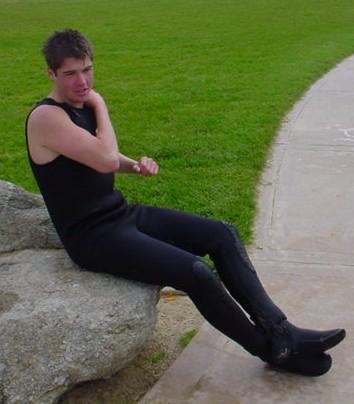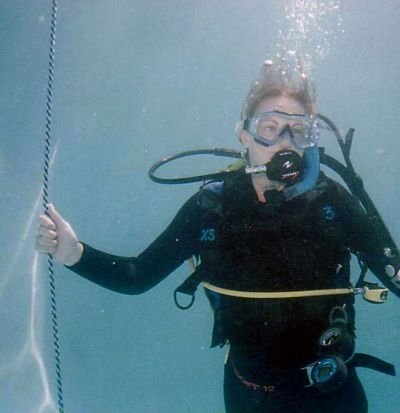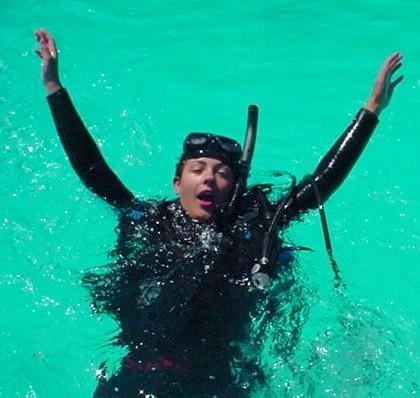Problem Solving
Accidents are rare, and most divers will never experience any form of diving related accident. This is due to the fact that divers are trained to obey important safety precautions and avoid unnecessary risks.
Incidents, on the other hand, do occur and some occur often. For this reason it's important to know what to do in those events so no harm comes to you or your buddy.
Serious emergencies and accidents such as out-of-air emergencies and unconscious divers rarely occur. However, knowing how to react to these situations can save a diver's life, so it's important that all divers know how to deal with these situations.
This lesson covers only the basics of problem solving and diver rescue. The Rescue Diver and First Aid/CPR courses are excellent specialty courses, and should be part of your continuing education goals.
Responding to Incidents
Common diving incidents include lost buddies, entanglements, disorientation, seasickness, breathing problems, and gear problems. These problems are easily resolved when handled appropriately. When ignored or handled inappropriately, these minor incidents can develop into diving emergencies or accidents.
No matter what happens, it's important to remain calm and concentrate on solving the problem. The general response to all diving incidents is to:
- Stop what you're doing, and signal to your buddy that something's wrong.
- Relax and breathe normally.
- Identify the problem.
- Continue to relax and breathe normally.
- Solve the problem.
Finding a Lost Dive Buddy
Buddy pairs occasionally become separated. This is usually the result of poor visibility, lack of communication, poor dive planning, or circumstances out of the diver's control. To locate a lost buddy:
- Stop as soon as you realize your buddy is lost.
- Swim back to where you last saw your buddy.
- Ascend to a shallower depth and look down for your buddy or rising bubbles.
- After 1 minute, if you still have not found your buddy, ascend to the surface.
- If your buddy does not surface within 5 minutes, call for help.
These procedures should be discussed with your buddy while planning the dive. This ensures that you'll both follow the same procedure, which will increase the success of your search.
Underwater Entanglements
Kelp, fishing line, nets, and rope may create an entanglement during a dive. The initial entanglement is usually very minor, but can worsen if you try to struggle yourself free.
Gear entanglements usually occur around the cylinder valve and fin straps. If you become entangled, signal to your buddy that something is wrong and point to the entanglement. You and your buddy should then work together to free the entanglement.
If you cannot pull the entanglement free, it may be necessary to cut it with a dive knife. This is rarely necessary, and most divers never have to use their knife for entanglements. Regardless, a dive knife should be carried on all dives for this purpose.

Air Starvation
Air starvation is a scary situation where you feel like you cannot breathe, and is usually the result of overexertion or an air restriction in your equipment.
If you have trouble breathing, immediately stop your activity and concentrate on slowing your breathing rate. Watch your submersible pressure gauge as you breathe, and look for movement in the needle. If the needle moves as you breathe, the cylinder valve might be partially closed. Open the valve if you can reach it, or seek assistance from your buddy if you need help.
If equipment problems are not responsible for your air starvation, you've probably overexerted yourself. If this is the case, stop your activity and relax until your breathing rate slows down to a pace your regulator can handle.
Power Inflator Malfunction
One of the most common gear related problems is a stuck or leaking power inflator. This is usually caused by particles of sand preventing the inflator valve from closing completely.
In the event your power inflator sticks in the inflate position, immediately disconnect the low-pressure hose from the power inflator and deflate the BCD to prevent an uncontrolled ascent to the surface.
If you are comfortable using the oral inflator to control your buoyancy underwater, you can continue the dive. Otherwise, use the oral inflator to establish neutral buoyancy, and make a safe ascent to the surface.

Heat Loss
Water conducts heat from your body 25 times faster than air. This is why it's important to wear appropriate thermal protection for the conditions you are diving in.
Even if you're wearing the most effective exposure suit available, it's still possible to become chilled while diving. This can lead to a serious condition called hypothermia, which is a drop in your internal body temperature. Symptoms of heat loss include shivering, numbness in the hands and feet, cramps, immobility, and an inability to think clearly.
If you develop any of these symptoms, immediately exit the water and get warm. To get yourself warm, remove your exposure suit, dry yourself off, and wear several layers of warm clothing. Warm drinks are helpful, but avoid caffeine. Stay out of the water until you have completely regained your body heat.

Overheating
As you'll learn very quickly, your exposure suit can be very warm when you're not in the water. If you're not careful, you can overheat and develop heat stroke before your dive begins.
Symptoms of overheating include pale and clammy skin, headaches, fatigue, and nausea. If you develop any of these symptoms, get wet as soon as possible to cool yourself down. If it's not possible to get in the water, remove your exposure suit and allow yourself to cool down.
The best prevention against overheating is timing. Wait to don your exposure suit until your buddy is ready to do the same, and get in the water as soon as possible.

Coughing and Choking Underwater
You may cough or choke if you accidentally inhale a small amount of water. You can minimize this risk by remembering to clear your regulator or snorkel before taking a first breath, and breathing slowly and carefully.
It's important not to ascend to the surface when you have any restriction in your airway. Doing so can prevent air from escaping your lungs and cause lung overexpansion injuries.
If you accidentally choke on water, remain calm and cough through your regulator. The water will eventually clear from your airway, and you'll be able to continue your dive.
Seasickness
Some people never get seasick. Others aren't so lucky and have to take special precautions. If you're one of those people, there are preventative measures you can take to avoid becoming seasick:
- Avoid greasy foods before a dive.
- Take non-drowsy motion sickness medications before you board the boat or begin the dive.
- Position yourself near the middle of the boat. This area has the least amount of movement.
- Look at the horizon. Motion sickness occurs when your body feels movement but does not see it. Viewing the horizon allows you to see the movement you are feeling.
If you become seasick while on the boat, vomit off the side of the boat on the downwind side, and do not dive. If you become seasick while underwater, vomit through your regulator, then switch to your octopus.
Underwater Disorientation
Disorientation refers to the sensation of not knowing where you are or even which way is up. The most common cause is sensory deprivation that occurs while diving in low visibility or at night. If you become disoriented, use a reference line such as kelp, an ascent line, or any other vertical reference to ascend. If a vertical reference is not available, follow your bubbles during ascent.

Out of Air Emergencies
As long as you plan your dives and monitor your air supply, you should never run out of air. But in the event you or your buddy has an out-of-air emergency, there are several methods available for surfacing.
You can share your air supply with your buddy by allowing your buddy to breathe from your octopus or another alternate air source. If an alternate air source is not available, you can share a single 2nd stage by using a method called buddy breathing. Both of these procedures allow two divers to ascend together while sharing a single air supply.
If you find yourself out of air and your buddy is not immediately available, you'll have to exhale your last breath as you swim to the surface. You can make it to the surface by using the emergency swimming ascent or emergency buoyant ascent.
The pages that follow explain the process for each of these methods.
Sharing an Alternate Air Source
Sharing air with an octopus or another alternate air source is the safest and preferred solution for an out-of-air emergency. To share air using an octopus:
- Your buddy signals that he/she is out of air, and needs air.
- Immediately locate your octopus and hand it to your buddy.
- Your buddy accepts the octopus, removes his/her 2nd stage, and replaces it with your octopus.
- Hold your buddy's right BCD strap with your right hand. Your buddy does the same. This leaves your left hand free to vent air from your BCD during ascent.
- When you and your buddy are ready to ascend, display the ascend signal and begin the ascent. Continue holding onto each other, and remember to maintain neutral buoyancy by periodically venting air from your BCD. Perform a safety stop if your air supply permits.
Buddy Breathing
Buddy breathing was the procedure of choice before alternate air sources became standard equipment. This method requires both divers to share a single 2nd stage.
When you buddy breathe, the donor takes 2 breaths from the 2nd stage, then passes it to the other diver. As that diver takes 2 breaths, the donor must exhale small bubbles while waiting for the 2nd stage to be returned. This process continues until the ascent is completed.
Your instructor will teach you how to buddy breathe, but as long as you have an alternate air source, you will never have to use it. Because of this skill's complexity, it's considered dangerous to use in an actual emergency unless both divers have practiced and mastered the procedure in controlled conditions.
Emergency Swimming Ascent
The emergency swimming ascent is the safest method to use if you run out of air and your buddy is not close enough to provide you with air. The recommended maximum depth for this procedure is 60 feet, but ascents from greater depths may be possible depending on the diver's abilities.
To make an emergency swimming ascent, maintain an open airway by looking up and exhaling a continuous stream of bubbles. As you swim to the surface, vent air from your BCD as necessary to maintain a controlled ascent rate.
The air in your lungs will expand as you ascend. This will produce the sensation of an endless breath of air as you exhale.
The air in your cylinder will also expand, and additional breaths may become available. For this reason, keep the 2nd stage in your mouth and attempt to take a breath as you near the surface.
Emergency Buoyant Ascent
The emergency buoyant ascent is the procedure of last resort to use when you fear you will not be able to maintain consciousness during an emergency swimming ascent.
To make an emergency buoyant ascent, remove your weight belt to establish buoyancy and allow your body to rise to the surface. Like the emergency swimming ascent, you must exhale continuously during the ascent to avoid overexpansion injury. You can slow your ascent rate by lying on your back and flaring your arms and legs out to the side.
Due to the dangers of a rapid ascent, you should never consider the emergency buoyant ascent as your first option in the event you run out of air. Instead, begin your ascent using the emergency swimming ascent. If at any time during the ascent you fear you will not be able to make it to the surface, you should then drop your weight belt to make an emergency buoyant ascent.
Your Role as a Dive Buddy
As a buddy, you will be the first to provide assistance to your buddy in the event of an incident or emergency. Usually this will be a minor incident such as an entanglement, equipment problem, or exhaustion from a tiring surface swim.
In the rare event of a serious injury or accident, you may be the only person who is aware of the problem and available to provide rescue assistance. Knowing how to react to these situations may save the other diver's life, so every diver should know the basic skills of a scuba diver rescue.
Always assess the situation before providing assistance, and then act to the best of your abilities. The only thing worse than one victim is two victims, so provide assistance only after determining it's safe to do so.
Tired Diver Tows
Surface swims can become tiring when the conditions are too harsh for a diver's abilities. If you notice that your buddy is having difficulty swimming at the surface, you should provide assistance to aid the diver during the swim.
Your instructor will teach you several tired diver tows during the confined and open water sessions. These include the tank valve tow, do-si-do tow, and push tow.
To use the tank valve tow, pull your buddy's tank valve as you swim on your side or back. This tow is very effective because your buddy can still help you swim during the tow. To use the do-si-do tow, link your arm with your buddy's as you swim on your side. To use the push tow, place your buddy's fins on your shoulders as you swim on your stomach.
Assisting Panicked Divers
A diver in distress at the surface is in serious danger of drowning and requires immediate assistance. After assessing the situation to make sure it's safe to respond, provide assistance by:
- Helping the diver establish buoyancy.
- Getting the diver to rest and breathe.
- Providing assistance as needed.
A diver in distress will be struggling to stay at the surface, and this struggle intensifies as panic increases. For this reason, your first priority is to help the diver establish buoyancy. Your first attempt should consist of verbal instructions to the diver to ditch the weight belt and inflate the BCD.
If the distressed diver is unresponsive to your instructions, you'll have to perform these tasks for the diver. This requires precautions on your part, as the diver is likely to attempt to climb on top of you in an effort to stay out of the water. The best way to prevent this from occurring is by approaching the diver from under the water, and behind if possible.
After establishing buoyancy, give the diver time to rest and catch his or her breath. Remain close to the diver, and provide words of encouragement to help the diver regain a state of mental comfort. Do not allow the diver to descend and continue the dive because a state of panic may reoccur.
Once the diver has had a chance to rest, assist the diver back to the boat or shore. If necessary, provide assistance by towing the diver during the surface swim.

Rescuing an Unconscious Diver
A serious accident or injury can lead to unconsciousness at the surface or underwater. The leading causes include drowning, lung overexpansion injury, and decompression sickness. No matter what the cause is, you must get the victim to the boat or shore, provide CPR if necessary, and contact emergency services.
If the diver is unconscious underwater, you must get the diver to the surface as soon as possible. To surface an unconscious diver:
- Check the diver for consciousness by waving your hand in front of his or her mask.
- Roll the diver onto his or her back, and remove the diver's weight belt.
- If the regulator is still in the victim's mouth, hold it in place with one hand.
- Ascend while holding onto the victim. Let go if the victim's buoyancy prevents you from controlling your ascent rate.
Once you and the victim are at the surface, the next priorities are to call for help, administer in-water artificial respiration if necessary, and transport the victim to the boat or shore. To transport an unconscious diver:
- Establish buoyancy for yourself by ditching your weight belt. Inflate both your own BCD and the victim's.
- Signal and call for help.
- Begin towing the victim using the do-si-do tow.
- Remove the victim's mask, and pull your own down around your neck.
- Check for breathing and provide artificial respiration if necessary.
- Continue calling for help.
- As you tow the victim, remove both the victim's and your own BCD. This will make the tow easier.
- Continue calling for help and providing artificial respiration.
Your instructor will demonstrate this process in more detail during your confined water sessions.